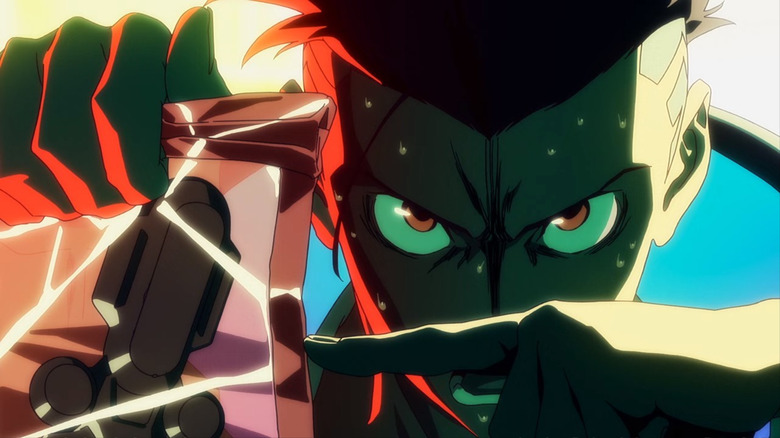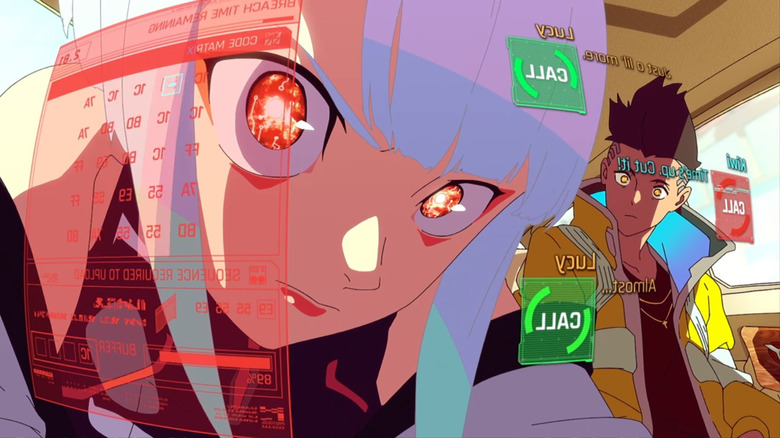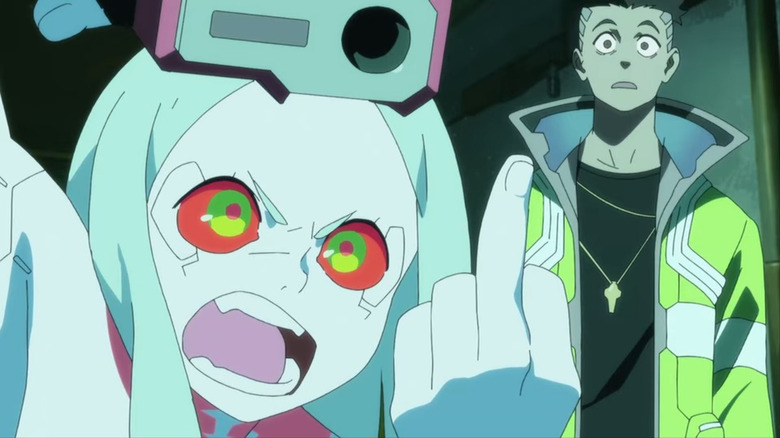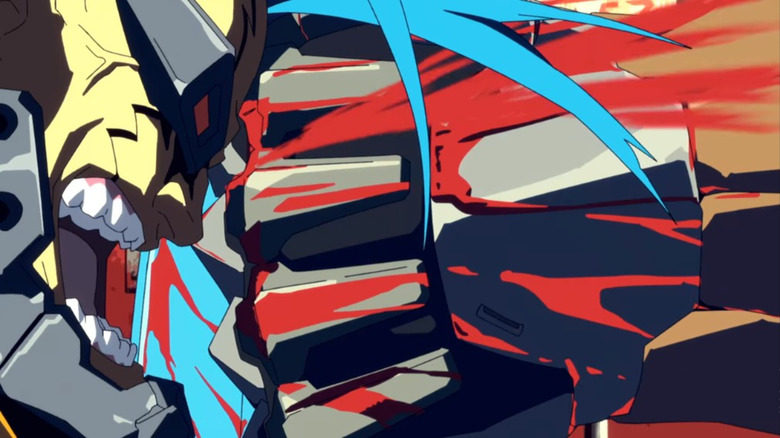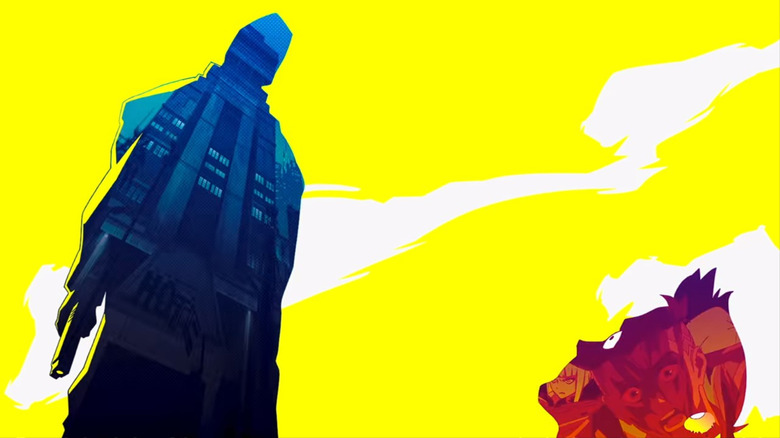Why The Director Of Cyberpunk: Edgerunners Loves Michael Bay
"Cyberpunk: Edgerunners" is an animated spin-off of "Cyberpunk 2077," a blockbuster sci-fi dystopian video game that itself was made in a pretty dystopian manner. It's also the newest show by Hiroyuki Imaishi, the director of "Gurren Lagann" and "Promare."
Imaishi started as an animator and director at the legendary studio Gainax before co-founding Studio Trigger with fellow Gainax staff including Yoh Yoshinari. His work features bombastic action, rude humor, and enough lens flares to give J.J. Abrams a headache. Imaishi's work is popular among international fans, some of whom were inspired to become animators themselves. Others argue that Imaishi's descendants, such as Yoshimichi Kameda and Imaishi's protege Akira Amemiya, have long surpassed him as animator and director respectively. Even so, "Edgerunners" holds its own in what is set to be a very busy fall for the anime industry.
Imaishi crams his animated works with references to shows, movies and comics he likes. Many of these are Japanese properties like "Mazinger," "Gutsy Frog," and "Combat Mecha Xabungle." But Imaishi also clearly loves media from the United States, including plenty of work that anime fans rarely bother themselves with. His burliest characters resemble 90s' beefcake superheroes drawn by Rob Liefeld and Todd McFarlane. His episode of "FLCL," a visually groundbreaking OVA released in 2000, featured a scene animated in the style of "South Park."
Of course, Imaishi is hardly the only anime director who loves American superhero comics; I was there at Otakon when premiere anime director Hiroshi Nagahama confessed that he would one day love to make a "Daredevil" movie. In order to find the root of Imaishi's personality as an artist we must go deeper. We have to talk about Michael Bay.
Believe in the me who believes in you
"Everyone laughs when they hear this," Imaishi said in a 2019 interview with the Japan Times, "but I love ('Transformers' and 'Armageddon' director) Michael Bay." This is the kind of statement that might cause anime fans to claw their eyes out in horror. Michael Bay is, after all, the man who made Bumblebee pee on a field agent in "Transformers." He is the man who punctuated a car chase in "Bad Boys II" with an avalanche of rolling corpses. Bay is a famous action film auteur in the same way that Sauron is a famous demigod who once sought to conquer Middle-earth.
"Every Frame a Painting" breaks down Bay's style in their video "Michael Bay — What is Bayhem?" One of Bay's favorite tricks is a low-angle shot captured via telephoto lens, framed against a background as the lead actor moves vertically into frame. Layers of depth, movement and parallax are leveraged to hit the viewer like a brick.
At the heights of his success, nobody could rival Bay's eye for scale and speed. But this was also Bay's greatest weakness. In the words of "Every Frame a Painting," "every shot is designed for maximum visual impact, regardless of whether it fits." When every scene in a Michael Bay film is framed as important, the audience is left confused as to what they should be paying attention to. The best Bay films contain sequences that are exciting in isolation, but the whole package more often feels boring and interminable.
Don't lose your way
Just like Michael Bay, Imaishi's directorial projects are concerned with feeling as big and as fast as possible. He loves setting his characters against huge and imposing environments to establish the stakes. When his characters argue, their faces consume the whole screen. When they fight, they punch each other through walls and throw each other hundreds of feet into the air. As Imaishi explained to the Japan Times: "I've always liked stuff that's screwy, exciting, just a little warped, a little excessive."
Other great action animators, like Yutaka Nakamura, are capable of elaborately staged swordplay where the viewer can sense the weight of every blow. Imaishi's characters by comparison do everything in bulk. Their limbs flail about like noodles as they bend and stretch crazily. Imaishi's animated series, shorts and movies are cartoons in the broadest sense. Detailed action choreography, the placement of each blow and the weight of the combatants are deemphasized in favor of speed and sheer quantity.
Over time, Imaishi has leaned on CG effects to amp up the scale and momentum. At the very beginning of "Kill la Kill," his first series at Studio Trigger, the "camera" zooms all the way out from the huge, fascist Honnouji Academy only to fly right back in as the heroine Ryuuko turns to show her face. Imaishi would continue to play with these effects while working on "Black Rock Shooter," a series based on a popular Hatsune Miku song.
Imaishi masterminded the show's fight scenes together with SANZIGEN, a CG studio affiliated with Trigger's joint holding company Ultra Super Pictures. SANZIGEN's early work was crude and unconvincing, but has steadily improved over time. Their original series "Bubuki Buranki" in 2016 sought to emulate the exaggerated appeal of a Trigger anime in CG. By the time that "Promare," Trigger's first feature film, released in 2019, SANZIGEN had leveled up once again.
I'll extinguish your flame with my burning soul
"Promare" is the closest Imaishi has ever come to making a straight-up Michael Bay movie. In the opening minutes, Galo the firefighter and Lio the pyrokinetic do battle across Promepolis. Lio drives the wheel of his motorcycle right into Galo's forehead, sending him flying. Hurtling through the air, Galo grabs onto the side of a skyscraper and opens a water valve, blasting himself along Promepolis's skyline. He rams straight into Lio, sending the two of them spinning right back where they came.
During these sequences the characters seamlessly transition between 2D and 3D models as they fall down corridors and through exploding glass windows. These scenes are just barely legible, but hold together due to color coordination and simple character designs. In their speed and sense of depth they are the height of what Imaishi has been working towards over the past several years.
Michael Bay's style isn't just about scale or speed. It's about making blockbusters with only other blockbusters as a reference. One of Bay's most reliable references is, of course, Michael Bay movies. As "Every Frame a Painting" says, "Bay cannibalizes himself just as much" as he does films made by other directors. Bay rebuilds scenes from his earlier films as bigger, faster and more complex versions. The resulting mutations grow grotesquely into horrors otherwise only found these days in Zack Snyder movies.
Frankly, Imaishi is just as prone to cannibalizing his own work as Bay. His comedy series "Space Patrol Luluco," meant to commemorate Trigger's anniversary, sends his heroine Luluco and her friends through the worlds of his previous anime. Even "Promare," which is set in an original world, shouts out "Gurren Lagann" and "Kill la Kill" in key scenes.
The most worthless trashy garbage in the universe
It should also be said that Imaishi's work is, for the most part, as trashy as it gets. "Gurren Lagann" and "Promare" are relatively restrained, but still feature their share of skimpy outfits and bad taste jokes. "Kill la Kill" goes much further, looping in just about every exploitative anime and manga trope into a festival of excess. "Cyberpunk: Edgerunners" is closer to "Kill la Kill" than "Promare," fully leaning into all the aesthetic strengths and weaknesses of the source material.
Imaishi's filthy sense of humor can be charming; I personally appreciate all the weird little pedestrians we see masturbating throughout "Edgerunners." At the same time, though, Imaishi doesn't do anything to challenge the assumptions of "Cyberpunk 2077," like the idea that body augmentation through machines inevitably leads to insanity. It's a conservative choice for a director whose work otherwise loudly and repetitively champions forces of creative chaos against repressive order.
But then, Imaishi loves trash so much that it's contagious. In "Space Patrol Luluco," the villain proclaims that a middle schooler's first crush is "the most worthless, trashy garbage in the universe." Yet to Luluco, the middle schooler in question, that first crush remains worth its weight in gold. This philosophy is at the center of nearly every Imaishi project. It may also be the key to his love of Michael Bay movies. Bay's films are superficial, nihilistic and unpleasant. But they are also bigger and louder than nearly anything else. For Imaishi, whose perfect movie might be two figures falling through hundreds of skyscrapers while the 3D camera revolves endlessly around them, you can see the appeal.
